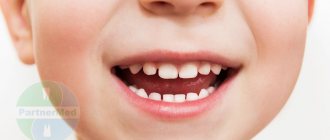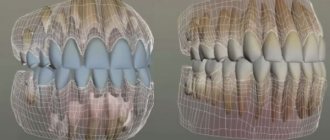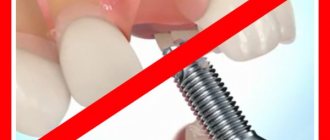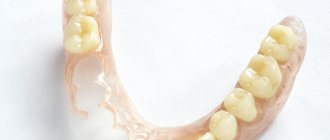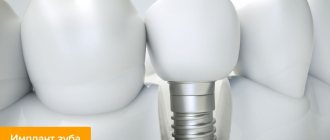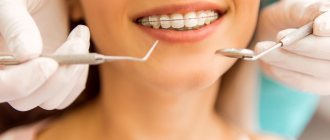The structure of baby teeth
Milk teeth are the first temporary teeth. It is believed that Hippocrates gave them their name. He believed that they are formed from mother's milk during breastfeeding.
The rudiments of baby teeth begin to develop in the womb - at 7-12 weeks of pregnancy. Their eruption begins at approximately 6-7 months of the baby’s life, and the process ends by 2.5-3 years. However, everything happens individually for each child.
Their structure is very similar to the structure of permanent ones, but they have their own characteristics by which they can be distinguished:
- their crowns are smaller in size,
- enamel and dentin are much softer and thinner, which often leads to rapid development of caries,
- the pulp cavity is extensive, which allows microorganisms to develop faster - passing through the thin walls of the crown, they affect the internal cavity much faster,
- their roots are less strong and massive, making their resorption easy and painless,
- their number is 20.
Attention! The timing of the eruption of the first teeth depends on the individual development of each child. They can be affected by heredity, place of residence, the course of pregnancy in the mother, nutrition, and previous diseases.
Approximate dates for the appearance of baby teeth:
- Central incisors on the upper and lower jaws – 6-8 months. The total number is 4.
- Lateral incisors, 2 on each jaw – 8-14 months.
- The first large molars, 2 on the upper and 2 on the lower jaw, erupt at 12-18 months.
- There are 2 fangs on each jaw - cut at 16-24 months.
- Second large molars (back teeth) – 4 teeth. Teething begins at 2 years of age and is completed at approximately 3 years of age.
Attention! Milk teeth play an important role in the development of a child - they are involved in the primary processing of food, the formation of the facial skeleton and the formation of the bite, and help the development of correct speech. Therefore, from the very first teeth, it is necessary to accustom the baby to hygiene and careful treatment of them - from the age of one year, start brushing them, limit sweets and do not forget about a timely trip to the dentist.
What are the differences?
Even outwardly identifying molars and baby teeth will not be difficult, because the difference between them is significant. But they also differ in their internal structure.
| Dairy | Permanent | |
| Features of teething | Often their appearance in the oral cavity is accompanied by not the most pleasant symptoms: inflammation of the mucous membrane, increased body temperature, excessive salivation and others. The baby becomes capricious, his appetite and sleep are disturbed, and his immunity decreases. | The permanent units of the series follow a pre-trodden path, and therefore their appearance is usually (in 90% of cases) not accompanied by difficulties. But when the third molars erupt, pain and discomfort are possible, and the process can drag on for a long time. |
| Crown size and shape | Small and short. During the period of change of bite, the child’s jaw gradually begins to expand, wide gaps form between the teeth. This is how nature intended it, taking into account the fact that the permanent units are larger and more space is needed for their full eruption. | Normally, a fairly large and long crown, if there are no bite pathologies, increased enamel abrasion, or bruxism. If you carefully examine the chewing units, you will notice that they are more convex than milk units and have voluminous tubercles on the coronal part. |
| Color | Whitish-blue tint. | Yellow, beige, brownish and even pinkish. |
| Fortress | Enamel (about 1 mm thick) and dentin are thin and fragile, there is no pronounced barrier between them [1], as in permanent units. They have weak mineralization in the chewing and cervical areas. | Solid fabrics are very durable. The enamel is 2.5 times stronger than that of children. |
| Features of the course of infectious and inflammatory processes | They are easily susceptible to chipping, acids, and bacteria, so caries and its complications develop rapidly and are multiple in nature (on several units in a row at once). In 2-3 months, caries can “eat” a tooth into a stub and lead to severe chipping of hard tissues. But the painful sensations are minimal due to the imperfection of the child’s nervous system. | If a tooth is exposed to pathogenic bacteria, then its demineralization, the development of caries and the destruction of hard tissues occur slowly and can last for years. But with inflammation, all the striking accompanying symptoms are present: a reaction to sweets, cold and hot, severe involuntary pain due to complications of caries, for example, pulpitis. |
| Structural features | They have a large pulp chamber, as well as straight and short dentinal tubules. This again explains why all dental pathologies develop faster in children. | The pulp is narrow, the dentinal tubules are long and curved, and therefore, in the event of destruction of enamel and dentin, bacteria move slowly through the insides of the tooth. |
| Root system | The roots are short. Therefore, if it is necessary to remove them, a shallow, quickly healing wound is formed in their place, and the risk of complications after surgery tends to zero. When a baby bite changes to a permanent one, the roots naturally dissolve, the tooth itself falls out without difficulty, and a new “tenant” erupts in its place - this is the norm. But if resorption occurs ahead of time, then this may indicate a pathology, for example, the development of periodontitis at the root. Damage to the root of the milk unit is dangerous for the rudiment of the constant, leading to disruption of formation, growth and normal eruption. | Long roots. To remove a permanent element, it is necessary to make significant efforts; sometimes you have to cut out the roots with a boron. Therefore, after surgery, tissues may hurt, swell, and bleed. With insufficient care and non-compliance with medical recommendations in the postoperative period, alveolitis develops. Nature does not intend for permanent roots to dissolve, but their resorption can occur under the influence of inflammatory processes in periodontal and periodontal tissues, due to traumatic factors. In this case, the roots become mobile, and the teeth themselves can easily fall out, which, of course, is not the norm. |
“In general, to be honest, I didn’t worry about the difference between baby teeth and molars. Just go to the pediatric dentist several times a year, who will tell you everything in detail and pay attention to problems, if any!”
Sveta_T_32, review from 32top.ru
“I was so scared when my son developed large gaps between his teeth at the age of 7. And the incisors that came out were simply huge, like a rabbit’s, especially compared to the neighboring fangs! But it turned out that this is normal. This means the jaw is growing. And vice versa, it’s bad if a change in bite has begun, and the incisors and canines are close to each other. Now, given this development of events, I would turn to an orthodontist. But, thank God, everything is fine with us.”
Alisa, review from gidpozubam.ru
Signs of baby teeth erupting
In some babies, their appearance is asymptomatic, and the mother accidentally discovers the first of them in her child’s mouth. For others, this process can be painful and difficult. At this point, the child’s immunity usually weakens, which may manifest itself in the following signs:
- emotional manifestations: irritability, crying, poor sleep,
- profuse drooling,
- digestive disorders - diarrhea, vomiting,
- refusal to eat,
- increase in body temperature to 37-38°,
- swelling and pain of gums,
- the desire to put everything in your mouth - bite, scratch your gums,
- “hanging” on the chest, sucking fists.
Difficulties that arise during the appearance of eights
| Pericoronitis. This is an inflammation of the gum tissue surrounding the visible part of the tooth. If you delay a visit to the dentist, purulent inflammation (abscess or phlegmon) may appear. Manifestation of pericoronitis: severe pain when opening the mouth or while eating, bad breath. In most cases, this disease occurs in 80% of people when the lower eights erupt. |
| Dystopia of the tooth. This is an incorrect position of the tooth in the jaw, that is, the eights can be located horizontally or at an angle. Over time, they begin to push against neighboring ones, leading to their destruction. Most often, dystopia is inherited. To avoid complications, it is recommended to remove dystopic wisdom teeth. |
| Retention. This is when the tooth has partially erupted or not erupted at all. If the tooth does not hurt and does not interfere with its neighbors, then it can be left. Conversely, if a tooth causes unbearable pain and destroys the roots of an adjacent tooth, then it should be removed. |
| Hidden caries . An affected wisdom tooth can cause caries to spread to other teeth; in this case, it is better to remove the tooth. |
Structure of permanent teeth
Permanent (molar) teeth are teeth that replace milk teeth. The process of loss and replacement of one with another begins at 5-6 years and ends at 13-14 years. Their total number is 32.
They have a crown, neck and root . Their fabrics are presented in layers:
- Enamel is a hard tissue that protects the internal cavity from external irritants. It covers the outside of the crown.
- Dentin is bone tissue. In the area of the crown, it is covered with enamel on the outside, and in the root with cement.
- Pulp is the soft, “living” part of the tooth. Contains many blood vessels and nerve fibers. Performs nutritional and sensitive functions.
Milk and molar teeth: what are their differences?
Externally, baby teeth and molars are very similar, but if you look closely, you will notice some visual differences: baby teeth are smaller in size, and the incisors and canines have a more rounded shape. The main differences are related to anatomy and structure.
- Primary teeth have thinner enamel with less mineralization.
- The root canals of baby teeth are much wider and, accordingly, more susceptible to the entry of pathogenic bacteria.
- The dentin layer of baby teeth is thinner, and the pulp is thicker.
- Milk teeth have roots, but they are less pronounced and dissolve during the process of changing the dentition.
Types of permanent (molar) teeth and the order of their appearance
Lack of vitamins, concomitant diseases or metabolic disorders can cause a delay in the appearance of permanent teeth. Also, shifts in the timing of teething depend on the anatomical and physiological characteristics of each child, climatic conditions, and the nature of nutrition. They usually appear in this order:
- The first large molars (molars) appear at 5-6 years of age.
- Then comes the replacement of the central incisors on the lower jaw.
- The upper central and lateral incisors on the lower jaw emerge almost simultaneously.
- At 8-9 years old, the upper lateral incisors are replaced.
- Until the age of 11-12 years, small molars (premolars) are replaced.
- At the age of 13, the canines are replaced.
- From about 14 years of age, the second pair of molars emerges, which are absent among the primary molars.
- From the age of 15, the third molars or “wise” teeth begin to emerge. Sometimes they remain in the gums until old age.
Problems with changing teeth
As with the eruption of baby teeth, molars can also be difficult to erupt. Sometimes the crown part of the tooth does not appear completely or is completely hidden in the soft tissues. This situation is usually called retention: it can be caused by improper or too deep seating of the germ, as well as late loss of a baby tooth in its place. Just as in the case of baby teeth, a child may have no molar rudiments at all: this happens due to metabolic disorders, insufficient mineralization or damage to the rudiments at the intrauterine stage of development. This can also occur when infections and inflammations are transferred from baby teeth and in some other individual situations. This problem can only be corrected by prosthetics or implantation after reaching adulthood.
Signs of the appearance of permanent teeth
Permanent teeth do not erupt asymptomatically, just like baby teeth . But due to age, a person’s immunity becomes stronger, which means the reaction will not be as acute. Their appearance is accompanied by the following signs:
- the appearance of gaps between baby teeth, which is due to the growth of the child’s jaw,
- loosening of teeth due to resorption of milk roots and their precarious position in the jaw,
- loss of the first temporary teeth - this indicates that the permanent one has “pushed” the milk one out of the gums and will soon erupt,
- swelling and pain of the gums are possible,
- loss of appetite,
- irritability.
This is interesting! There are cases when a child is born with baby teeth. They are called natal. There are also cases of the appearance of neonatal teeth - these are those that erupted in the first 30 days of a child’s life. They come complete, that is, they are simply cut through ahead of schedule. And there are additional ones - grown in addition to the main set. The doctor decides what to do in such cases.
What is important to pay close attention to
We looked at the main difference between baby teeth and permanent teeth. We found out that the latter are stronger and more durable due to their structural features. However, it is important to understand that the permanent units that have just erupted (the change of incisors occurs at approximately the age of 5-9 years, canines - 9-13 years, premolars - by 12-14 years) are not yet sufficiently mineralized. That is, they do not have the necessary strength. Their final mineralization occurs within the next two years after eruption.
Expert opinion
Tatyana Vitalievna Varlamova
Specializations: Dentist-therapist
Experience: 2015
“Many parents still think that baby teeth do not need treatment and prosthetics if they have been subjected to dental pathologies. All hope is that soon the child will have a permanent bite, in which the enamel and dentin are very strong. But it is important to know that the well-being and safety of the dairy crop also depends on the health of the dairy crop. Early removal of temporary elements and damage to their roots affects the rudiments of permanent elements and leads to developmental anomalies.”
Therefore, the teeth of children aged 7 to 15 years need especially careful care, strengthening, and control by parents and dentists. That is, they seem to be already permanent, but at first they are still very weak, which is why they are easily susceptible to caries and other dental pathologies.
How to distinguish a baby tooth from a molar
Despite the similar structure of primary and permanent teeth, molars have a number of distinctive properties :
- Quantity is the main difference. The milk set contains 20 teeth, and the permanent set contains 32 teeth.
- Magnitude. Dairy products are 2 times smaller than indigenous ones.
- Color. Temporary ones have a bluish-white tint, while permanent ones have a yellowish tint.
- Dates of appearance. The first teeth erupt at the age of 6-7 months, permanent teeth - at 5-6 years of age.
- Shape and width of crowns. In dairy animals they are more pronounced than in permanent ones.
- Roots. In milk teeth they are short and tend to dissolve, while in permanent teeth they are longer and firmly attached to the jaw.
- Kinds. The set of primary teeth includes incisors, canines and molars; the permanent set contains incisors, canines, molars and premolars.
- Fabrics. The thickness of permanent enamel is 2 times greater than that of dairy enamel.
- Pulp cavity. For temporary ones it is much more extensive than for permanent ones.
Note! Baby teeth fall out on their own; permanent teeth can only be removed instrumentally.
What is missing in a child’s mouth: let’s figure it out
As we have already found out above, a person has molars and milk teeth in different numbers. The difference is that children do not have molars or otherwise “sixes” and “sevens” in their bite, as well as wisdom teeth, which are called “eights” and “third molars.” Molars appear as the jaw grows and expands and does not have milk predecessors - they erupt around 13-14 years. Third molars also have no predecessors, but can emerge at any age - at 20, 30, 40 and even 60 years. Or they may not appear at all.
On a note! In adults, from 1 to 4 third molars may grow, or none may erupt at all, which is the norm these days, since they are considered rudiments. This explains why the number of teeth in the permanent dentition varies from 28 to 32. But often the “sages” cause problems for the owners, since they come out incompletely, in the wrong place and in the wrong way, and ultimately destroy neighboring units and contribute to the development of infectious and inflammatory processes. And then it is recommended to delete them.
Are all children's baby teeth replaced by permanent ones?
There are cases when it is possible to observe baby teeth in adults. Why does this happen? The main reasons are:
- The rudiments of permanent teeth are laid too deep in the gums and do not affect the roots of milk teeth. This happens due to a lack of free space in the gum or incorrect roots.
- Absence or underdevelopment of permanent tooth buds. This can be caused by a genetic predisposition, disruption of the endocrine system, previous injuries to the jaw, or inflammatory processes in baby teeth.
Dentists individually determine the fate of a baby tooth in adulthood in each case. If it is not loose and in good condition, there is no rush to remove it. The decision is made after an X-ray examination, which will show whether there are the makings of a permanent tooth and whether the roots of the baby tooth are preserved. It is also possible that the root will never come out .
In the case when the baby tooth is loosened, is in an unhealthy condition and in the absence of the rudiments of a permanent one, the question of prosthetics or restoration of the child’s tooth will arise. This is also observed - the makings of a permanent tooth have not emerged, but the baby tooth has fallen out. Then the orthodontist must perform prosthetics.
Adults also have milk “long-livers”
Yes, this is indeed possible. Milk teeth, which have a different structure and difference from permanent ones, may well be preserved in the bite of an adult. Whether to remove them, save them or replace them with prosthetics - this must be decided by the doctor depending on the clinical situation. For example, if they do not have the rudiments of permanent units under them, then you can simply improve the shape and aesthetics of the crown part so that they do not stand out in size against the background of their full-fledged “neighbors.” Read more about this phenomenon in the feature article on the website.
Are all children's teeth baby teeth?
By the age of 3, the baby should have 20 baby (temporary) teeth in his mouth. In the future, they should be replaced by permanent ones. The first ones begin to fall out when the molars move closer to the exit of the oral cavity and “push” them. The breasts become loose and fall out on their own, often painlessly.
Important! When temporary teeth fall out and new teeth erupt, soft tissue ruptures may occur. Therefore, during this period it is necessary to carefully monitor oral hygiene - be sure to brush in the morning and evening, rinse the mouth after each meal, and promptly heal carious areas to avoid infection of permanent teeth.
Some mothers and fathers want to know: what kind of teeth are in the child’s mouth, have the permanent ones come out yet or are they still baby teeth? This can be determined by their configuration . The primary set consists of incisors, canines and large molars. There are no premolars in the milk series. Starting from the central incisor, towards the cheeks, there should be 5 teeth on each half of the jaw. If you find 6 or 7, these are already permanent.
The shape also matters. The temporary one has a wide crown and 4 masticatory cusps, the permanent one has 2 cusps. Primary canines are smaller than permanent ones; their sharp end is usually worn away by the time they are replaced with molars. In case of doubt, an x-ray will give the exact answer.
Healthy, beautiful teeth, regardless of their type, are not only a gift that was inherited from parents. A lot depends on careful attitude and daily care!
Symptoms of wisdom teeth erupting
Features of growth
Symptoms of the appearance of wisdom teeth
If your wisdom tooth grows incorrectly
How to relieve pain when wisdom teeth erupt
If a wisdom tooth grows during pregnancy
Eights, also known as wisdom teeth or third molars, are the most “problematic” teeth. They are the last to erupt, from about 16 to 30 years of age. At this age, the jaw is already formed, so the eights simply do not have enough space in the dentition, so when they appear, they begin to cause discomfort.
How to relieve pain when wisdom teeth erupt
The easiest way to get rid of unpleasant symptoms is to take over-the-counter painkillers.
- To relieve pain and fever: Nurofen, Ibuprofen, Nimesulide, Paracetamol.
- To eliminate pain: “Spazmalgon”, “Ketanov”, “Analgin”, “Pentalgin”, etc.
- Antiseptics to relieve symptoms and prevent complications: Miramistin, Chlorhexidine, Furacilin, etc.
- For local pain relief: “Kamistad”, “Kalgel”, “Cholisal”.
You can use folk remedies.
- Rinse solution made from salt and soda. Dissolve 1 teaspoon of salt and soda in a glass of warm water. It is recommended to rinse your mouth no more than 3 times a day.
- Rinse solution made from propolis tincture. Stir 7-8 drops of tincture in a glass of warm water. The solution is also a natural antiseptic.
- Cold compress. Under no circumstances should it be hot - heat may cause inflammation.
- Sage decoction. Pour 1 tablespoon of sage into a glass of boiling water, leave for an hour, strain. You can rinse until relief occurs.
Relieving pain during wisdom tooth eruption is only a short-term solution. A competent consultation with a doctor will help you cope with pain and possible complications.
